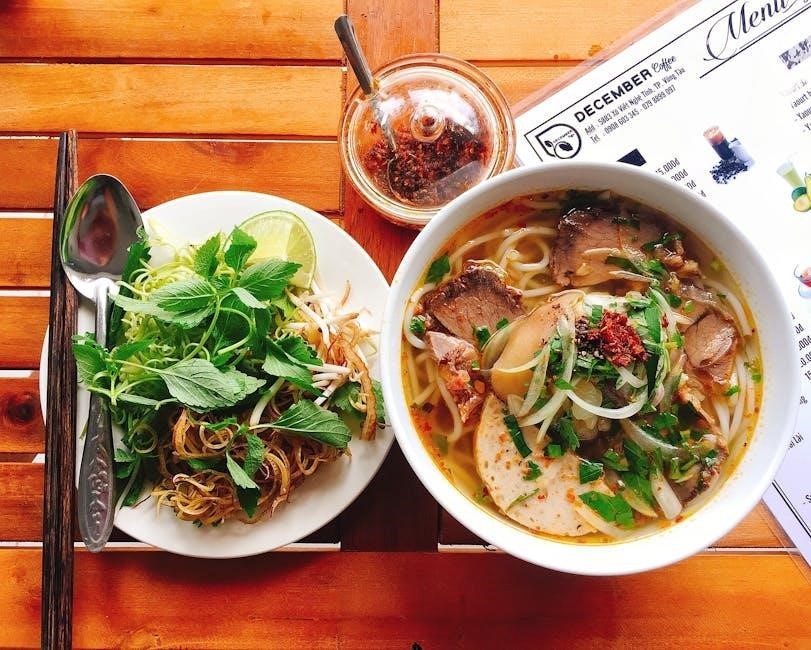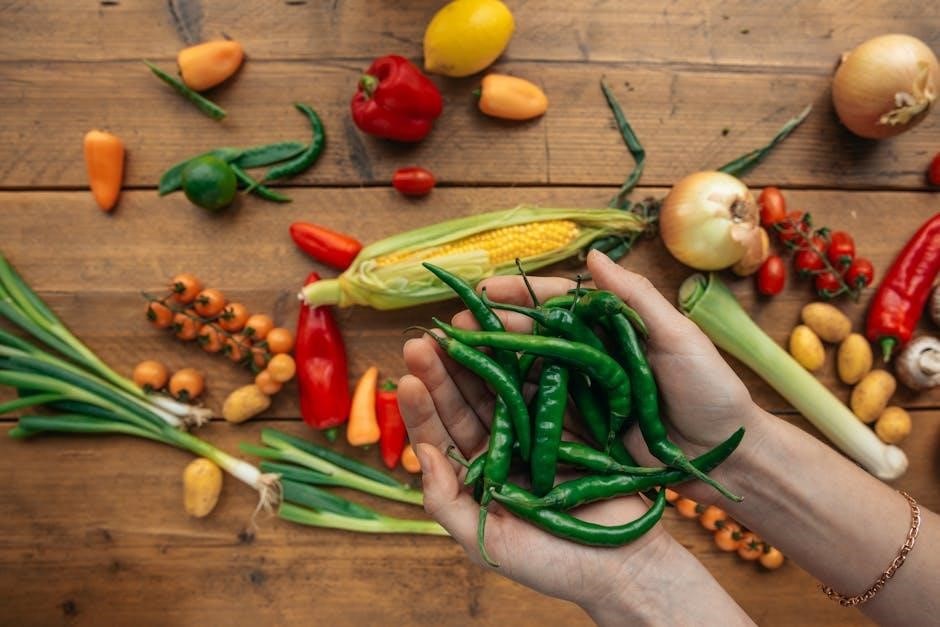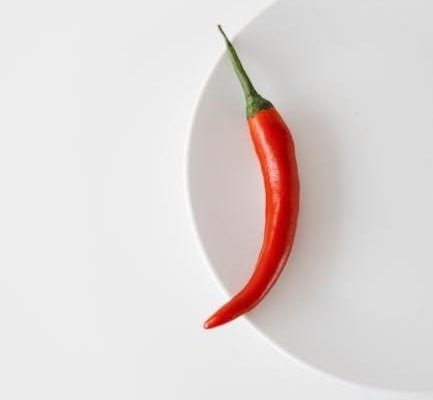A Chili Cook-Off Judging Sheet is a structured tool used to evaluate entries based on criteria like taste, texture, aroma, color, and creativity, ensuring fair and consistent scoring.
Overview of Judging Sheets
Judging sheets are detailed forms used to assess chili entries systematically. They typically include sections for event name, date, category, and contestant information. Each sheet outlines scoring criteria like taste, texture, aroma, color, and creativity, with a scoring range (e.g., 0-10). Judges assign scores for each category, add comments, and select winners. These sheets ensure consistency, fairness, and transparency in the evaluation process, making them indispensable for chili cook-offs.

Importance in Ensuring Fair Judging
Judging sheets play a critical role in maintaining fairness by standardizing evaluation criteria. They prevent bias by ensuring all entries are assessed consistently. Judges evaluate each chili based on predefined categories, eliminating personal preferences. This structured approach minimizes variability and ensures that winners are selected based on merit. The use of numbered entries and anonymous judging further enhances fairness, making the process transparent and trustworthy for all participants.

Key Criteria for Judging Chili
Chili is evaluated based on taste, texture, aroma, color, and creativity, ensuring a comprehensive assessment of each entry’s quality and appeal.
Taste
Taste is the most critical factor in chili judging. Judges assess flavor balance, depth, and complexity, ensuring the chili is neither too bland nor overpoweringly spicy. A good chili should have a harmonious blend of ingredients, with each component complementing the others. Proper seasoning and the quality of the base ingredients, such as meat or vegetarian alternatives, significantly impact the overall taste. Judges often look for a finish that leaves a lasting, pleasant impression, enhancing the dish’s appeal.

Texture
Texture plays a vital role in chili judging, as it contributes to the overall sensory experience. Judges look for a smooth, well-balanced consistency, avoiding extremes like dryness or sogginess. The chili should not be grainy, lumpy, or greasy, ensuring a pleasant mouthfeel. Proper cooking techniques are essential to achieve the ideal texture, where ingredients blend harmoniously without being overly mushy or undercooked. A well-textured chili enhances the dish’s appeal and reflects the cook’s skill in preparation and ingredient management.
Aroma
Aroma is a critical factor in chili judging, as it sets the tone for the overall flavor experience. Aroma should be inviting, with a balance of spices, herbs, and slow-cooked ingredients. Judges evaluate how well the fragrance complements the taste, ensuring it’s neither overpowering nor bland. A strong, appealing aroma enhances the dish’s appeal and indicates a well-crafted blend of flavors, making it a key element in the judging process.
Color
Color plays a significant role in chili presentation, as it reflects the dish’s quality and appeal. A vibrant, rich color, often deep red or brown, indicates a well-prepared chili. Judges expect the color to be even and inviting, avoiding pale or murky appearances. The color should complement the other criteria, enhancing the overall impression of the dish. A visually appealing chili often sets the tone for a positive judging experience.
Creativity
Creativity in chili cook-offs is about showcasing unique ingredient combinations and innovative cooking techniques. Judges look for originality in flavor profiles, such as unexpected spices or unconventional ingredients. A creative chili stands out by offering a fresh twist on traditional recipes while maintaining balance and appeal. This criterion rewards chefs who push boundaries and deliver a memorable, one-of-a-kind dish that captivates the palate and imagination.
How to Score Chili Effectively
Use a scoring range of 0-10 for each category, evaluating taste, texture, aroma, color, and creativity. Judges must remain impartial, ensuring scores reflect objective assessments. Provide clear, legible ratings on the judging sheet to determine fair winners. Consistency and transparency are key to maintaining the integrity of the competition.
Scoring Range and Instructions
Judging sheets use a 0-10 scoring range for categories like taste, texture, aroma, color, and creativity. Judges assign whole-number scores, with 10 being the highest. Scores are recorded legibly on the sheet, ensuring clarity. Instructions emphasize impartiality, advising judges to evaluate each chili independently. Clear guidelines help avoid bias, ensuring fair competition. Judges should review criteria before scoring and provide optional comments for feedback. Scores are tallied to determine winners, making accurate, consistent scoring essential for a fair outcome. Properly filled-out sheets are crucial for smooth results compilation.
Assessing Each Category
Judges evaluate each chili based on predefined categories such as taste, texture, aroma, color, and creativity. Taste is prioritized, with scores reflecting how well flavors balance. Texture should be smooth and consistent, avoiding extremes like dryness or sogginess. Aroma must be appealing, enticing the senses. Color should appear vibrant and appetizing. Creativity rewards unique ingredients or methods. Judges use a clean spoon for each sample to prevent cross-contamination and cleanse their palates with water and crackers between tastings to ensure unbiased assessments. Each category is scored independently to maintain fairness and accuracy, with comments optional for feedback to contestants. This systematic approach ensures a thorough and impartial evaluation of each entry. Proper assessment of each category is vital for determining the overall quality and ranking of the chili entries, helping to identify the most deserving winners in a fair and transparent manner.
Ensuring Consistency Among Judges
To maintain consistency, judges use standardized criteria and scoring systems. All judges review the same evaluation categories, such as taste, texture, and aroma, ensuring uniformity in assessments. Entries are anonymized with numbered table tents to eliminate bias. Judges are trained to score independently, avoiding comparisons between entries. Palate cleansing with water and crackers between tastings helps prevent flavor fatigue. Clear scoring guidelines and discussions among judges ensure fairness and accuracy, fostering a reliable and transparent judging process. This approach guarantees that each chili is evaluated on its own merits, promoting equitable competition and clear winners.
Designing a Judging Sheet
A well-designed judging sheet includes sections for event name, date, chili categories, and scoring criteria. Judges can easily record scores, comments, and ingredient lists for each entry.

Essential Elements of the Sheet

An effective judging sheet must include entry identification (name, number, category), scoring criteria (taste, texture, aroma, color, creativity), a scoring range (0-10), and space for comments. It should also list ingredients for allergy considerations and provide clear instructions for judges, such as using numbered table tents to ensure anonymity. Additionally, a section for judges to sign and date their scores ensures accountability and transparency in the evaluation process.
Example Layout and Format
A judging sheet typically starts with header information such as the event name, date, and location. Below, entries are listed with their assigned numbers and categories. The scoring section includes criteria like taste, texture, and aroma, each on a new line with a 0-10 rating scale. A comments section allows judges to provide feedback. The sheet may also include a table format for organization, with columns for entry numbers, scores, and notes, ensuring clarity and ease of use during evaluations;

Tools and Resources for Judges
Judges require scorecards, water, crackers, and spoons for palate cleansing. Printable templates and detailed criteria sheets ensure consistency and fairness in evaluating chili entries effectively.
Necessary Tools for Judging
Judges require essential tools to evaluate chili effectively. These include scorecards for rating entries, clean spoons for tasting, and water with plain crackers for palate cleansing. Numbered table tents ensure anonymity, while ingredient lists from cooks help identify allergens. A secure, legible writing instrument is crucial for recording scores accurately. Judges may also use a criteria reference sheet to guide their evaluations consistently. These tools collectively ensure fairness, organization, and transparency in the judging process.
Recommended Resources and Downloads
Enhance your judging experience with downloadable resources. Printable judging sheets, scorecards, and chili name cards are available online. PDF templates for chili cook-off judging sheets offer structured formats for fair evaluation. Additional tools include ingredient checklists for allergen awareness and judging criteria guides. These resources ensure consistency and efficiency, making the process seamless for both organizers and judges. Utilize these downloads to streamline your event and maintain high standards of fairness and transparency throughout the competition.

Common Mistakes to Avoid
Common errors include inconsistent scoring, failing to clear palates between tastings, and neglecting to review all judging criteria. These oversights can lead to unfair outcomes and disorganization.
Avoiding Judging Pitfalls
Common pitfalls include inconsistent scoring, failure to clear palates between samples, and neglecting to review all criteria. Judges should avoid comparing chilies directly and ensure impartiality by using numbered samples. Food allergies and ingredient disclosures must be handled carefully to prevent disqualification. Palate fatigue can be mitigated with water and crackers.Scores should reflect objective criteria, not personal preferences. Ensuring legibility on score sheets is crucial for accurate results. Proper training and clear guidelines help judges avoid these common errors.
Handling Food Allergies and Preferences
Handling food allergies and preferences is crucial for a fair and safe judging process. Each cook must provide a detailed list of ingredients to alert judges of potential allergens. Judges with specific dietary restrictions should notify organizers in advance to ensure alternatives are available. Clear communication and transparency are essential to accommodate all needs without compromising the integrity of the competition. This step ensures inclusivity and safety for all participants and judges. Proper precautions prevent health risks and maintain a positive experience for everyone involved.
Case Studies and Examples
Case studies highlight successful chili entries, such as a chili scoring x2 1st place and x1 2nd place, showcasing judging consistency and criteria effectiveness in competitions.
Real-Life Judging Scenarios
In a workplace chili cook-off, judges used a scorecard with numbered entries, ensuring anonymity. One entry received two first-place and one second-place votes, demonstrating the scoring system’s effectiveness. Judges evaluated based on taste, texture, and aroma, with clear guidelines to avoid bias; This scenario illustrates how structured judging sheets ensure fair and transparent competition outcomes, making the selection process credible and enjoyable for all participants involved in the event.
Successful Cook-Off Outcomes
A well-organized chili cook-off with clear judging criteria ensures a positive experience for participants and attendees. Using structured judging sheets, events can determine fair winners, enhancing credibility and participant satisfaction. Successful outcomes often feature enthusiastic competition, delicious entries, and a smooth awards process, fostering community engagement and excitement for future events. Clear scoring systems and transparent judges’ feedback contribute to the success and enjoyment of chili cook-offs, making them memorable and rewarding experiences for all involved.

Best Practices for Hosting a Cook-Off
Ensure clear communication of rules, provide essential tools like judging sheets, and maintain organization to guarantee a smooth and enjoyable event for participants and attendees alike.
Organizational Tips
Assign each chili entry a unique number for anonymous judging. Provide scorecards with clear criteria like taste, texture, and aroma. Ensure ingredient lists are available for allergy concerns. Use numbered table tents to identify entries without revealing cooks’ names. Have water and crackers on hand for judges to cleanse their palates. Maintain a clean, organized judging area with essential tools. Communicate rules and judging processes clearly to all participants and judges beforehand to ensure a smooth event.
Award Distribution and Ceremony
The ceremony concludes the cook-off, celebrating winners with awards like “Best Overall Chili” and category-specific prizes. Winners are determined by tallying judges’ scores from the judging sheets. Awards often include certificates, plaques, or trophies. Ensure all participants are recognized for their efforts. Clearly present each award, explaining the criteria behind the win. This fosters a sense of achievement and encourages future participation. The ceremony should be well-organized, with awards distributed in a fair and transparent manner, honoring the hard work of all cooks.
